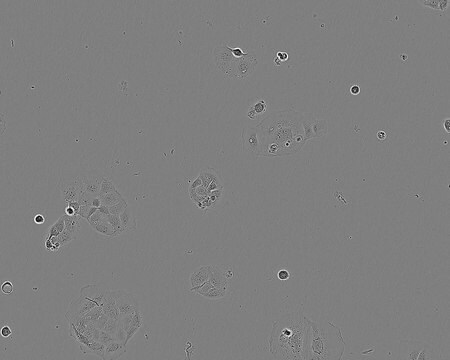U-2 OS Cell Line human
NOTE: Both the cell line and DNA from the cell line may be available for this product. Please choose -1VL or VIAL for cells, or -DNA-5UG for DNA, 92022711, human bone, Not specified
Sinonimo/i:
U-2OS Cells, U2-OS Cells, U20S Cells, U2OS Cells
About This Item
Prodotti consigliati
Origine biologica
human bone
Confezionamento
tube of 5 μg 92022711-DNA-5UG
pkg of vial of cells 92022711-1VL
Modalità di accrescimento
Adherent
Cariotipo
Not specified
Morfologia
Not specified
Prodotti
Not specified
Recettori
Not specified
tecniche
cell culture | mammalian: suitable
Malattie correlate
cancer
Condizioni di spedizione
dry ice
Temperatura di conservazione
−196°C
Origine della linea cellulare
Descrizione della linea cellulare
Applicazioni
- the importance of cyclin D1 for the activity of lithocholic acid hydroxyamide (LCAHA)
- the interaction of human single-stranded DNA binding protein 1 (hSSB1) with bloom syndrome protein helicase (BLM helicase)
- calcium-mediated actin reset (CaAR) in response to physiological changes
Profilo DNA
CSF1PO: 13
D13S317: 13
D16S539: 11,12
D5S818: 11
D7S820: 11,12
THO1: 6,9.3
TPOX: 11,12
vWA: 14,18
Terreno di coltura
Mantenimento delle subcolture
Altre note
Scegli una delle versioni più recenti:
Certificati d'analisi (COA)
It looks like we've run into a problem, but you can still download Certificates of Analysis from our Documenti section.
Se ti serve aiuto, non esitare a contattarci Servizio Clienti
Possiedi già questo prodotto?
I documenti relativi ai prodotti acquistati recentemente sono disponibili nell’Archivio dei documenti.
Articoli
Regulation of the cell cycle involves processes crucial to the survival of a cell, including the detection and repair of genetic damage as well as the prevention of uncontrolled cell division associated with cancer. The cell cycle is a four-stage process in which the cell 1) increases in size (G1-stage), 2) copies its DNA (synthesis, S-stage), 3) prepares to divide (G2-stage), and 4) divides (mitosis, M-stage). Due to their anionic nature, nucleoside triphosphates (NTPs), the building blocks of both RNA and DNA, do not permeate cell membranes.
Il team dei nostri ricercatori vanta grande esperienza in tutte le aree della ricerca quali Life Science, scienza dei materiali, sintesi chimica, cromatografia, discipline analitiche, ecc..
Contatta l'Assistenza Tecnica.




